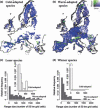Climate change threatens European conservation areas
- PMID: 21447141
- PMCID: PMC3116148
- DOI: 10.1111/j.1461-0248.2011.01610.x
Climate change threatens European conservation areas
Abstract
Europe has the world's most extensive network of conservation areas. Conservation areas are selected without taking into account the effects of climate change. How effectively would such areas conserve biodiversity under climate change? We assess the effectiveness of protected areas and the Natura 2000 network in conserving a large proportion of European plant and terrestrial vertebrate species under climate change. We found that by 2080, 58 ± 2.6% of the species would lose suitable climate in protected areas, whereas losses affected 63 ± 2.1% of the species of European concern occurring in Natura 2000 areas. Protected areas are expected to retain climatic suitability for species better than unprotected areas (P < 0.001), but Natura 2000 areas retain climate suitability for species no better and sometimes less effectively than unprotected areas. The risk is high that ongoing efforts to conserve Europe's biodiversity are jeopardized by climate change. New policies are required to avert this risk.
© 2011 Blackwell Publishing Ltd/CNRS.
Figures




References
-
- Alagador D, Martins MJ, Cerdeira JO, Cabeza M, Araújo MB. A probabilistic-based approach to match species with reserves when data are at different resolutions. Biol. Conserv. 2011;144:811–820.
-
- Araújo MB. Matching species with reserves - uncertainties from using data at different resolutions. Biol. Conserv. 2004;118:533–538.
-
- Araújo MB, Guisan A. Five (or so) challenges for species distribution modelling. J. Biogeogr. 2006;33:1677–1688.
-
- Araújo MB, New M. Ensemble forecasting of species distributions. Trends Ecol. Evol. 2007;22:42–47. - PubMed
MeSH terms
LinkOut - more resources
Full Text Sources
Medical

